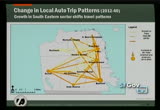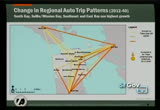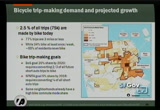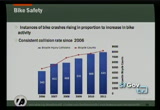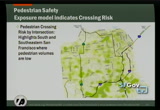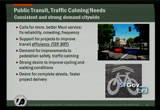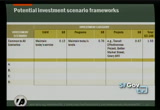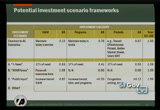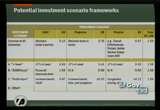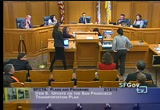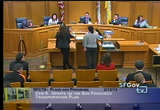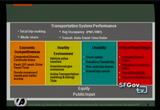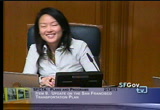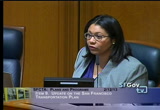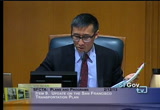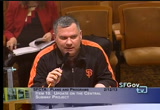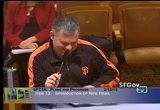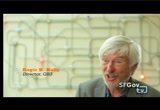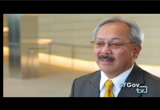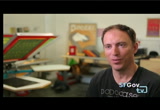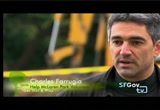tv [untitled] March 1, 2013 4:30am-5:00am PST
4:30 am
smaller percentage but many more riders. this map shows growth in auto trip making just within san francisco, so these are trips that both start and end in san francisco, and they're driving trips and we see significant driving in the southeast part of the city and the eastern part of the city where so much growth is expected. travel to and from sonoma, mission bay, to and from the polls, southeast quadrant of the city. >> wow. >> and this is showing similar information at auto trip growth, but where one trip is outside of san francisco, so they're regional trips. one end is in san francisco and one end is outside the city and a lot of growth and trip making between san francisco and the south bay,
4:31 am
between the south bay and the southern parts of the city and eastern parts of our city and to and from sonoma. this is growth in transit trip making as it would translate into increased crowding and we know that there's crowding today on our system and without investment in the fleet plan, tep, without increasing in capacity that crowding will increase especially on the eastern and the southeastern parts of the network where so much of the new employment and housing is expected. and then finally the equity lens. we know that there are some neighborhoods in san francisco that experience some of these system performance problems more acutely than others, and we can break the
4:32 am
summaries down that way to identify those neighborhoods. this picture is an example of that. it shows how many transfers on average a transit rider needs to make depending on the neighborhood, the origin of their trip, and there are certain parts of the city taking a transit trip requires many more transfers than other places. mta's recently pedestrian sector work and area sector work has identified the top needs for the modes and we can draw from that work as we develop the investment scenarios. the map is from the mta's bicycle strategy and even though on average the bike mode share per
4:33 am
trip is two half percent. there are some cases -- in this case the commute bike share is a lot higher in many neighborhoods so there is a lot more opportunity even though the goal is a long way off. this is a map of the current bicycle network and it shows again there's a lot of opportunity to it connect the network, reduce some of the fragmentation in the current network. the bulletses there are what mta identified in the strategy for this move. the bike trip making has been growing very significantly over the last decade, and bike collisions have also increased. unfortunately the collision rate isn't going up but we want to see it go down so that is a
4:34 am
goal of future investment in the bike system. this is a map from mta's pedestrian strategy, and what it shows is so-called high injury density corridors and those corridors that experience the most pedestrian collisions and severe and fatal pedestrian collisions in absolute terms and what we know that the downtown and the soma and the inner mission experience the greatest volumes of pedestrian collisions, are most frequently involved in the sites of collisions. we also know that in terms of the pedestrian rates the southeast part of the city, 19th avenue, the southern part of san francisco, has the greatest risk for pedestrian collisions and so that's a matter of comparing the number
4:35 am
of collisions that happen to the number of pedestrians. there are fewer pedestrians, but greater risk for collisions. and then finally public outreach that we have been doing throughout the update has really produced consistent themes from the public as far as priorities, the basics, more reliable service, less crowdie muni, improvements for safety traffic calming and biking and walking and not so much interest in project demand but interest in faster project delivery. this reflects to some of the conversations about traffic calming and wanting to see improvements happen faster in their neighborhoods. this is something that we can also address through policy
4:36 am
recommendations and our strategic initiatives and address the policy reforms that we or other agencies can take to get the most out of our investments, so with needs in mind and goals in mind the next step is begin think going the investment scenarios, finally constrained investment scenarios and this table is set up to think about that. there are three main types of categories of investment if you will and those are the columns here. operations and maintenance, both of the transit system, all operators as well as of the street networks so street resurfacing and reconstruction. there are programs, and those are the small scale relatively small scale improvements that we can't necessarily identify today but we use the five year prioritization process to
4:37 am
identify and traffic calming and pedestrian and safety and signs and those are all programs and finally expansion and major capital projects and transit effectiveness project and these other projects, so one -- just to get us started one way of thinking about investment scenarios. well, just take the discretionary funds that we have and if you remember back to some of the revenue discussions in the past with information items there is 3.1 billions dollars in truly discretionary funds to prioritization through the sft p and split it among the groups i think close to .6 in
4:38 am
each category, so that's one way of doing it, or you could think about addressing sort of a similar percentage of need in each category, and so this -- what you see is an example of that. take that 3.14 billion sort of achieve a certain similar percentage of the need in that category across all categories. and there are other ways to think about the guiding framework for the investment scenario. we could focus on sogr exclusively and we will continue the historic levels of funding and programs. we will invest in the top projects that have gotten a lot of development so far, the tep, geary brt and with the rest of the funds focus
4:39 am
on sogr operations and maintenance. >> [inaudible] >> state of good repair. >> state of good repair. >> yes. and that includes the repair of both the transit system and the street network so transit, capital, the vehicles, the overhead trolley wires, keeping them in repair as well as pot holes and street reconstruction. >> thank you. >> so then another way of thinking about it this line, row is called the public input, and what this scenario does is generally reflect the priorities that we have heard as we have done outreach on the sftp and that is a lot of interest in transit operations and maintenance, and then a lot of interest in programs, especially in traffic calming, bike and
4:40 am
pedestrian programs, and that would be the focus for a scenario like that. we are just at the beginning stages of thinking about how financially constrained investment scenario would be structured, and so we know we will have further information items on this topic and further ways to get input from you on that. we are also proceeding with the policy sector work. that is questions about project delivery both for small and large projects and whether there are creative ways we can recommend change in that area, and then finally revenue strategy. we're working on a revenue paper to identify and
4:41 am
make recommendations on the revenue side, and yes -- >> sorry just to finish up. julie [inaudible] and thank you for the time and we anticipate coming back every month to meet the schedule. we are talking with chair avalos for a separate workshop and we apologize for not having the last few slides for you, but we will add them to your packet. these are important questions. we really seek your guidance -- sorry, you do have the hand outs, but we want to make sure we have adequate time to discuss these and perhaps look for a separate workshop on the topic. >> and maybe this isn't the appropriate time to ask this since we are workshopping it later. by the way this report
4:42 am
was great and great to see the colors and the diagrams. i think you heard the exclamations from commissioners and i know that this is going to be a highly competitive plan but it's one of many tools we have to evaluate, but i am curious beyond the number of vehicle trips the transit crowding how we do take account the other issues and the length of time a project is identified? some have been in the pipeline for a while. the projected growth and [inaudible] in infrastructure and pedestrian and public safety. how do we -- >> how do we put it all together? >> how do you put it all together. >> that's the challenge. let's look at the slide. we are looking at the four goals and the needs for today and the needs for the future and
4:43 am
already the cac said don't forget about the projects and not pulled to the new growth. we also see better choices for the people on the outer part of the city and there is a geographic dimension and we are going to take the lens and where we have outliers in terms of performance and we need to bring the technical and policy pieces together and with the public and the best judgment. we will give you recommendations but we seek your advice. ultimately it's a policy decision to allocate the resources. one thing is for the vision. we have 12 bill whereon in needs. how.
4:44 am
>> >> they have been tharzed -- there is a state wide conversation as well. we have an opportunity to look at the sales tax for transportation, our prop k, so there is an opportunity in the next months to have the conversation about new revenues and what is the appropriate way to propose the use of potentially new revenues to meet all of the needs in the city. >> if i can make one more -- >> go ahead. >> one more point. it would be helpful. i think the equity issue is really well and i don't represent those neighborhoods in in that sector but nice to know how it impacts the ones closer to a center and a lot of the cars have to go through different districts. >> next month we will come back to you on a particular item on the central core circulation study we have been doing and pulling together the mission work and the eastern
4:45 am
neighborhoods work and all of this so it's reflected in one place. >> it would be helpful to understand that. thank you. this is very enlightening. >> thank you. >> thank you. commissioner breed. >> i just want a point of clarity because the information we received i know sometimes it changes, and i don't have the most updated version of your presentation. >> oh i'm sorry. >> i do have the additional slides with this information, but while i prefer to receive information prior to this meeting, but if there are changes it would be helpful to have that in order to follow along and use it for reference and replace information that might be dated. >> right. our apologies for that. we had three slides that just came in over the weekend. >> but this is not all complete
4:46 am
either. >> oh i apologize. okay. sorry for that. we will do better. >> so i think often what's in our packets comes on friday, and then if before presentation you could provide us with the most up dated ones that would be helpful. >> yes. we will do that. >> and thanks rachel for a great presentation. let's open it up for public comment. anyone wish to speak? seeing none. ms. ching since we are going into the second hour i'm going to direct staff to make these items shorter and i'm going to ask to continue
4:47 am
items 10 and 11 but we should open it up for public comment. colleagues, can we continue items 10 and 11? any objection? let's open this up for public comment. mr. griswald. >> yes, i just wanted to say on item 10 the central subway. let's see. i moved here when i was 21 and i remember when people were talking about the central subway going to chinatown and maybe even north beach and i was so excited and now i turned 50 on january 1 and i hope i am still around to see the central subway, so i really urge the committee and the commissioners and the ta and everybody -- i know there are some controversy around the central subway but i look forward to the central subway
4:48 am
and going to chinatown. and i do go to chinatown believe it or not supervisor campos, but it's really exciting and it's an exciting project and i hope it stays on track. thank you. >> thank you. is there anyone else in the public that would like to speak? seeing none public comment is closed and i should mention that commissioner chiu has requested that we continue item 10 as well for further discussion, so colleagues we heard a motion and a second we're going to continue items 10 and 11. without objection. ms. ching next item. >> item 12 is introduction of new items. >> i see no new items. let's open it up for public comment. anyone from the public that would like to speak? >> you're going to being sick of me. i just want to say as an informational item to the commissioners i want better signage and traffic calming for
4:49 am
market and ger rareo and laguna. we have a lot of development going on there and we're going to have a lot of new residents there, so i wish the commissioners and i am sure commissioner wiener will have input on this, but we need traffic calming definitely and better pedestrian safety, and especially we're sandwiched between the octavia boulevard and the central freeway and we need some attention, and i feel that we're not getting that, and i know commissioner kim when it was in her district she tried, but it's just not enough. i mean -- and like i said outreach is important. we have a gay community center there. there are meeting rooms there. the ta and commission staff should be meeting with the public or the neighbors in the area. even now we're in supervisor wiener's
4:50 am
district and i think there's some kind of -- i don't know how to say since the transfer of the being gobbled up in district eight. there's been -- >> we're trying to wrap up the meeting. please continue. >> pardon me? >> we're trying to wrap up the meeting. >> okay. i am just using my time if that is okay. all right. thank you. >> thank you. anyone else from the public that would like to speak? seeing none public comment is closed. ms. ching please call the next item. >> item 13 public comment. >> let's open this up. anyone from the public who would like to speak? seeing none. mis ching any other items? >> no. next item is adjournment. >> thank you. we're adjourned.
4:59 am
77 Views
IN COLLECTIONS
SFGTV: San Francisco Government Television Television Archive
Television Archive  Television Archive News Search Service
Television Archive News Search Service 
Uploaded by TV Archive on

 Live Music Archive
Live Music Archive Librivox Free Audio
Librivox Free Audio Metropolitan Museum
Metropolitan Museum Cleveland Museum of Art
Cleveland Museum of Art Internet Arcade
Internet Arcade Console Living Room
Console Living Room Books to Borrow
Books to Borrow Open Library
Open Library TV News
TV News Understanding 9/11
Understanding 9/11